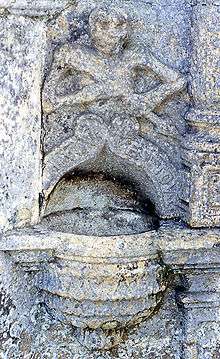Ankou
Ankou (Breton: /ɑːnkuː/ an Ankoù) is a servant of Death commonly mistaken for a personification of death in Breton mythology as well as in Cornish (an Ankow in Cornish), Welsh (yr Angau in Welsh) and Norman French folklore.[1]

Background
Ankou is reported by Anatole Le Braz—a 19th-century writer and collector of legends. In his work, The Legend of Death, he wrote:
- The Ankou is the henchman of Death (oberour ar maro) and he is also known as the grave yard watcher, they said that he protects the graveyard and the souls around it for some unknown reason and he collects the lost souls on his land. The last dead of the year, in each parish, becomes the Ankou of his parish for all of the following year. When there has been, in a year, more deaths than usual, one says about the Ankou:
- – War ma fé, heman zo eun Anko drouk. ("On my faith, this one is a nasty Ankou.")
There are many tales involving Ankou, who appears as a man or skeleton wearing a cloak and wielding a scythe, and in some stories he is described as a shadow, often atop a cart for collecting the dead. He is said to wear a black robe with a large hat which conceals his face.[1] According to a Celtic local legend, he was the first child of Adam and Eve.[2] Other versions depict Ankou as being the first dead person of the year (though he is always depicted as a male adult), charged with collecting others' souls before he can go to the afterlife.[3] He is said to drive a large, black coach pulled by four black horses and accompanied by two ghostly figures on foot.[1][4]
One tale says that there were three drunk friends walking home one night when they came across an old man on a rickety cart. Two of the men began shouting at the Ankou and threw stones. When they broke the axle on his cart, they ran off.
The third friend felt pity and, wanting to help the Ankou, found a branch to replace the broken axle and gave the Ankou his shoe-laces to tie the axle to the cart. The next morning, the two friends who were throwing stones at the Ankou were dead while the one who stayed to help only had his hair turned white. He would never speak of how it happened.
Another story of the origin of Ankou is he was once a cruel prince who met Death during a hunting trip and challenged him to see who could kill a black stag first.[1] Death won the contest and the prince was cursed to roam the earth as a ghoul for all eternity.[1]
Appearance in subcultures
Every parish in Brittany is said to have its own Ankou.[1] In Breton tradition, the squealing of railway wheels outside one's home is supposed to be Karrigell an Ankou ("The Wheelbarrow of Ankou").[5] Similarly, the cry of the owl is referred to as Labous an Ankou ("The Death Bird").[5] The Ankou is also found on the baptismal font at La Martyre where he is shown holding a human head.[6]
In Ireland, there is proverb that states, "When the Ankou comes, he will not go away empty".[1]
Celtic Folklore of Brittany
It is said that the Ankou is a death omen that collects the souls of the deceased and is the king of the dead whose subjects have their own particular paths along which their sacred processions move.[7] The Ankou is the last person to die in a parish every year and will assume the duty of calling for the dead. They describe the Ankou as a tall, haggard figure with long white hair and perceived as a skeleton with a revolving head that is able to see everything, everywhere. The Ankou is said to drive a cart that stops at the house of someone who is about to die. It knocks on the door, which is sometimes heard by the living, or it could release a mournful wail like the Irish Banshee. Additionally, the Ankou has been reported as an apparition entering houses, taking away the dead who are then placed in his cart with the help of two ghostly companions.[8]
See also
- Arawn a Welsh king of the Otherworld
- Death (personification)
References
| Wikimedia Commons has media related to Ankou. |
- "Ankou". The Element Encyclopedia of the Psychic World. Harper Element. 2006. p. 25.
- Williams, Victoria (2016). Celebrating Life Customs Around the World: From Baby Showers to Funerals. Santa Barbara, California: ABC-CLIO. p. 11. ISBN 9781440836596.
- Abel, Ernest L. (2009). Death Gods: An Encyclopedia of the Rulers, Evil Spirits, and Geographies of the Dead. USA: ABC-CLIO. p. 20. ISBN 9780313357138.
- JENNY REES (11 April 2005). "ANIMATORS GET TO GRIPS WITH WELSH MONSTERS". Western Mail.
- Badone, Ellen (1987). "Death Omens in a Breton Memorate". Folklore. Taylor & Francis, Ltd. 98: 99–101. doi:10.1080/0015587x.1987.9716401. JSTOR 1259406.
- Doan, James (1980). "Five Breton "Cantiques" from "Pardons"". Folklore. Taylor & Francis, Ltd. 91 (1): 35. doi:10.1080/0015587x.1980.9716153. JSTOR 1259816.
- Wentz, W. Y. (1911). The Fairy-faith in Celtic Countries. Reprinted. Colin Smythe (1981). ISBN 0-901072-51-6. P. 218.
- http://www.mythicalcreaturesguide.com/page/Ankou